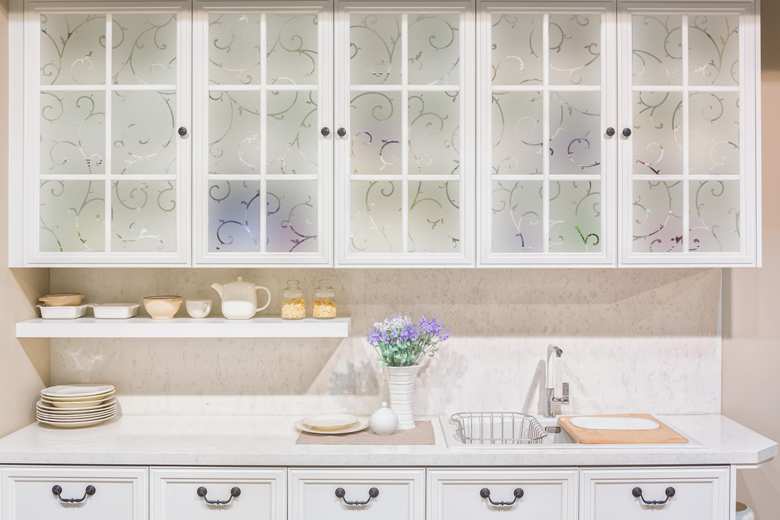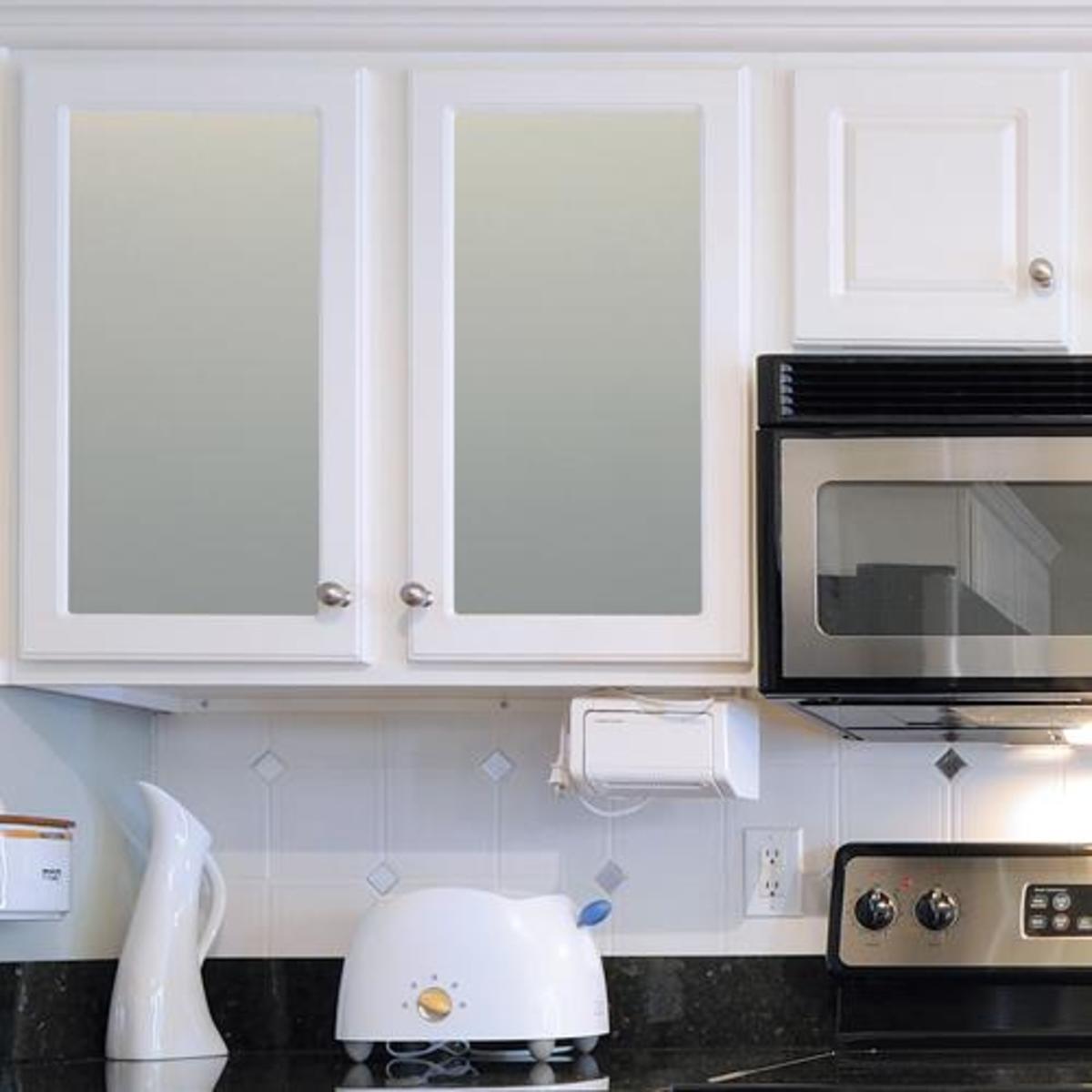Types of Film for Glass Cabinet Doors

Transforming ordinary glass cabinet doors into stylish and functional features is achievable with the application of decorative films. These films offer a range of options, each with its unique aesthetic appeal and practical benefits.
Frosted Film
Frosted film, also known as privacy film, is a popular choice for glass cabinet doors. It creates a translucent, frosted appearance that diffuses light, obscuring the view while still allowing some light to pass through. This makes it ideal for creating a sense of privacy without completely blocking out light.
The advantages of frosted film include its ability to enhance privacy, its ease of application, and its affordability. However, it’s important to note that frosted film may not offer complete privacy, as some Artikels or shadows might still be visible.
Etched Film
Etched film simulates the look of etched glass, creating a sophisticated and elegant appearance. It features a textured surface that adds depth and dimension to the glass. Etched film is available in various patterns, from subtle lines to intricate designs, allowing you to personalize your cabinets.
Etched film offers a high level of privacy, effectively obscuring the view behind the glass. Its durability and resistance to scratches make it a practical choice for high-traffic areas. However, it may be more expensive than other film types and can be more challenging to apply.
Patterned Film, Film for glass cabinet doors
Patterned film provides a wide array of design options, from geometric patterns to floral motifs. It adds a decorative touch to glass cabinet doors, enhancing the overall aesthetic of your kitchen or bathroom.
Patterned film can enhance privacy, depending on the chosen pattern. It is generally easy to apply and offers a cost-effective way to add a touch of style to your cabinets. However, it may not offer the same level of privacy as frosted or etched film.
Privacy Film
Privacy film is specifically designed to enhance privacy by creating a one-way mirror effect. This type of film allows you to see through the glass from the inside while making it difficult to see through from the outside.
Privacy film is ideal for cabinet doors in bathrooms, bedrooms, or other areas where privacy is paramount. It is highly effective in blocking unwanted views and offers a high level of privacy. However, it may be more expensive than other film types and may require professional installation.
Applications and Uses

Film for glass cabinet doors – Glass cabinet doors are a common feature in homes, offices, and retail spaces, offering a sleek and modern aesthetic. Applying film to these doors opens up a world of possibilities for enhancing their appearance, functionality, and durability. From adding privacy to creating unique designs, film offers a versatile solution for various applications.
Applications in Different Settings
The versatility of film allows for its application in a wide range of settings, transforming the look and feel of glass cabinet doors.
- Kitchens: In kitchens, film can add a splash of color, create a frosted effect for privacy, or mimic the look of stained glass. It can also protect the glass from scratches and spills, making it easier to clean.
- Bathrooms: Bathrooms benefit from film’s ability to provide privacy while still allowing natural light to filter through. Frosted or patterned films create a spa-like ambiance, while decorative films can add a touch of elegance.
- Offices: In offices, film can be used to create private meeting rooms or break areas. It can also be used to brand glass doors with company logos or designs, enhancing the professional image of the space.
- Retail Spaces: Retail spaces can leverage film to create eye-catching displays. Window film can be used to advertise products or showcase special promotions, while frosted film can be used to create privacy in dressing rooms or back rooms.
Enhancing the Look of Cabinet Doors
Film can transform the look of glass cabinet doors in numerous ways, adding a touch of personality and style.
- Color: Film comes in a wide range of colors, allowing you to match your cabinet doors to your existing décor or create a bold statement.
- Patterns: From geometric designs to floral motifs, film offers a variety of patterns that can add visual interest and depth to cabinet doors.
- Textures: Textured films can create a unique tactile experience, adding another dimension to the appearance of your cabinet doors.
- Etched Glass Effects: Film can mimic the look of etched glass, creating a sophisticated and elegant appearance.
Adding Privacy
Film can provide privacy without sacrificing natural light, making it ideal for areas where transparency is desired but not complete visibility.
- Frosted Film: Frosted film creates a translucent barrier that obscures views while allowing light to pass through, offering a balance between privacy and brightness.
- Patterned Film: Patterned films can create a more decorative and interesting privacy solution, with designs that add visual appeal while obscuring views.
Protecting the Glass Surface
Film acts as a protective barrier for glass cabinet doors, safeguarding them from scratches, spills, and other damage.
- Scratch Resistance: Film provides a protective layer that resists scratches, ensuring your cabinet doors remain pristine for years to come.
- UV Protection: Film can protect your cabinet doors from harmful UV rays, preventing fading and discoloration over time.
- Impact Resistance: Some films offer impact resistance, protecting your cabinet doors from accidental bumps and collisions.
Sample Kitchen Layout
Imagine a modern kitchen with sleek white cabinets. To showcase the versatility of film, we can incorporate different types in various areas:
- Upper Cabinets: A frosted film on the upper cabinets provides a soft, diffused light while maintaining privacy for stored items.
- Lower Cabinets: A patterned film with a subtle geometric design adds visual interest to the lower cabinets, creating a unique and stylish look.
- Glass Doors on Pantry: A clear film with a UV protection layer shields the glass doors on the pantry from fading caused by sunlight, while preserving the clear view of the contents.
Installation and Maintenance: Film For Glass Cabinet Doors

Installing film on glass cabinet doors is a relatively straightforward process that can be completed with a few essential tools and materials. This section provides a step-by-step guide for a successful application, along with techniques for achieving a smooth, bubble-free finish and detailed instructions for cleaning and maintaining the film-covered surfaces.
Tools and Materials
Before embarking on the installation process, gather the necessary tools and materials to ensure a smooth and successful application.
- Film: Select the appropriate film type based on your desired aesthetic and functional requirements.
- Measuring tape: Measure the glass cabinet doors accurately to ensure a perfect fit for the film.
- Utility knife: Use a sharp utility knife to trim the film precisely to the dimensions of the glass doors.
- Squeegee: A squeegee is essential for smoothing out the film and eliminating air bubbles.
- Spray bottle: Fill a spray bottle with soapy water for a smooth application and easier repositioning.
- Microfiber cloth: A microfiber cloth is ideal for wiping away excess water and ensuring a clean finish.
- Scissors: Use scissors to trim any excess film around the edges of the glass doors.
- Ruler: A ruler is helpful for precise measurements and ensuring straight cuts.
- Level: A level is crucial for ensuring the film is applied evenly and without distortion.
- Tape measure: Use a tape measure to ensure accurate measurements and proper film placement.
Preparation
Proper preparation is key to achieving a professional-looking installation.
- Clean the Glass: Thoroughly clean the glass cabinet doors with a mild detergent and warm water. Ensure the surface is free of dust, dirt, and grease. This will create a smooth and adhesive-friendly surface for the film.
- Measure the Glass: Measure the glass cabinet doors accurately to determine the required film dimensions. Add a small margin around the edges to allow for trimming after application.
- Cut the Film: Using a sharp utility knife and ruler, cut the film to the measured dimensions. Ensure the cuts are precise to prevent uneven edges and a less-than-ideal finish.
Application
The application process requires a steady hand and a methodical approach.
- Spray the Glass: Spray the cleaned glass surface with a generous amount of soapy water. This will create a slippery surface that allows for easy repositioning of the film during application.
- Position the Film: Carefully position the film on the wet glass surface. Ensure it is centered and aligned with the edges of the glass door. Take your time to adjust the position before proceeding to the next step.
- Squeegee the Film: Using a squeegee, smooth out the film from the center outwards, eliminating any air bubbles or wrinkles. Work your way towards the edges, applying even pressure to ensure a smooth and bubble-free finish. If air bubbles persist, gently lift the film at the edge of the bubble and re-squeegee to release the trapped air.
- Trim the Film: Once the film is fully adhered to the glass, use a sharp utility knife and ruler to trim any excess film around the edges. Ensure the cuts are clean and precise to create a professional-looking finish.
Maintenance
Regular cleaning and maintenance are crucial for preserving the longevity and aesthetic appeal of the film-covered glass cabinet doors.
- Avoid Abrasive Cleaners: When cleaning film-covered glass, avoid harsh chemicals, abrasive cleaners, and scouring pads. These can damage the film and cause scratches, compromising its appearance and longevity.
- Use a Microfiber Cloth: For everyday cleaning, use a soft microfiber cloth dampened with warm water. Gently wipe the surface to remove dust, fingerprints, and smudges. Avoid using harsh cleaners that can damage the film’s protective layer.
- Avoid Excessive Heat: Direct exposure to excessive heat, such as from a stovetop or oven, can cause the film to warp or distort. Keep film-covered glass cabinet doors away from direct heat sources to maintain their shape and integrity.
Achieving a Bubble-Free Application
A smooth, bubble-free application is crucial for a professional-looking finish.
- Use Soapy Water: Applying the film with a soapy water solution creates a slippery surface that allows for easy repositioning and eliminates the risk of air bubbles forming during application.
- Squeegee Methodically: Use a squeegee to smooth out the film from the center outwards, working your way towards the edges. This technique helps to release trapped air and ensures a smooth, bubble-free finish.
- Address Bubbles: If air bubbles persist, gently lift the film at the edge of the bubble and re-squeegee to release the trapped air. This technique effectively eliminates air bubbles and ensures a smooth and professional-looking finish.
Film for glass cabinet doors can offer a stylish and functional upgrade, adding a touch of privacy or a decorative element. But to truly showcase the beauty of your glass panels, consider using cabinet glass retainer clips plastic for a sleek and secure finish.
These clips offer a modern alternative to traditional hardware, creating a minimalist aesthetic that complements the clean lines of your glass doors.
Film for glass cabinet doors offers a subtle way to enhance the look of your kitchen. It can help to create a more cohesive aesthetic, especially if you have a lot of dishes on display. If you’re looking for inspiration on how to arrange your dishes for a stunning display, check out this article on how to arrange dishes in glass cabinets.
Once you’ve mastered the art of dish arrangement, you can consider adding a film to your glass cabinet doors for a polished and refined touch.
